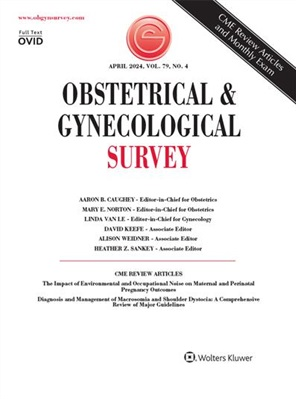Clinical Utility of sFlt-1 and PlGF in Screening, Prediction, Diagnosis and Monitoring of Pre-eclampsia and Fetal Growth Restriction
IF 4.3
4区 医学
Q1 OBSTETRICS & GYNECOLOGY
引用次数: 2
Abstract
ABSTRACT Preeclampsia is a serious hypertensive disorder of pregnancy that can deteriorate into eclampsia or HELLP syndrome and ultimately result in severe maternal morbidity or mortality. In addition to possible complications for the mother, preeclampsia and its additional complications can lead to adverse outcomes for infants, both before and after birth. Because of the serious consequences associated with preeclampsia, current practice guidelines recommend the screening of all pregnant patients for risk of preeclampsia in the first trimester and consistent monitoring for the development of preeclampsia later in pregnancy. Recommendations also include that women who are diagnosed with preeclampsia are closely monitored to prevent further complications such as preterm birth, as well as monitoring for fetal growth restriction (FGR). There are serum markers that are known to be related to preeclampsia, such as proangiogenic placental growth factor (PlGF) and antiangiogenic soluble fms-like tyrosine kinase-1 (sFlt-1). This article is a review aiming to summarize current knowledge about PlGF and sFlt-1, their performance, and potential alteration in diagnosis and monitoring of preeclampsia. Factors such as these have trends that occur in normal pregnancy and different trends that tend to occur in a pregnancy that is abnormal. In a healthy pregnancy, sFlt-1 increases in the third trimester, but in patients who later develop preeclampsia or FGR, it tends to increase sooner. Recent studies have shown that the interaction between sFlt-1 and PlGF reduces the amount of PlGF in circulating in the blood, causing a cascade of other effects. In addition, a decrease in PlGF is known to be associated with the development of preeclampsia. Because of this interaction, the ratio of sFlt-1 to PlGF can be used as a diagnostic tool; an increasing ratio can indicate development of preeclampsia. In addition to predicting preeclampsia, sFlt-1 and PlGF have been shown to be helpful in managing preeclampsia that has already been diagnosed. Monitoring the ratio of sFlt-1 to PlGF has shown a correlation between a higher ratio and imminent preterm delivery due to preeclampsia. It has also proven to be a predictor of other adverse outcomes such as preterm delivery and FGR, as well as stillbirth and complications of multiple pregnancies. Recent data show robust enough associations between sFlt-1 and PlGF that it can reasonably be used for predicting short-term development of preeclampsia, monitoring preeclampsia that has been previously diagnosed and predicting other disorders of the placenta. These factors can be particularly useful in guiding treatment of those whose symptoms are not a clear enough indicator on their own for preeclampsia, but who may be in danger of complications if left untreated. In particular, the most impactful clinical outcome comes when both sFlt-1 and PlGF levels are monitored, as the interaction between the 2 gives the most relevant information, whereas one or the other alone has not been shown to have practical value. Understanding the clinical utility of these levels indicates that there could be many benefits to integrating testing of the sFlt-1/PlGF ratio into preeclampsia screening and testing regimens; it could help clarify the need for treatment and predict the development of complications, which in turn could help clinicians prevent or treat complications for better outcomes for both mother and child.sFlt-1和PlGF在子痫前期和胎儿生长受限筛查、预测、诊断和监测中的临床应用
子痫前期是一种严重的妊娠高血压疾病,可恶化为子痫或HELLP综合征,最终导致严重的孕产妇发病率或死亡率。除了母亲可能出现的并发症外,子痫前期及其其他并发症可导致婴儿出生前和出生后的不良后果。由于与子痫前期相关的严重后果,目前的实践指南建议在妊娠早期筛查所有妊娠患者的子痫前期风险,并在妊娠后期持续监测子痫前期的发展。建议还包括对被诊断为先兆子痫的妇女进行密切监测,以防止进一步的并发症,如早产,并监测胎儿生长受限(FGR)。有一些血清标记物已知与子痫前期有关,如促血管生成胎盘生长因子(PlGF)和抗血管生成可溶性膜样酪氨酸激酶-1 (sFlt-1)。本文综述了PlGF和sFlt-1在子痫前期诊断和监测中的作用。诸如此类的因素有在正常妊娠中出现的趋势,也有在异常妊娠中出现的不同趋势。在健康的妊娠中,sFlt-1在妊娠晚期增加,但在后来发展为子痫前期或FGR的患者中,它往往增加得更快。最近的研究表明,sFlt-1和PlGF之间的相互作用减少了血液循环中PlGF的数量,从而引起一系列其他效应。此外,已知PlGF的减少与先兆子痫的发生有关。由于这种相互作用,sFlt-1与PlGF的比值可以用作诊断工具;比值增大提示先兆子痫的发展。除了预测子痫前期,sFlt-1和PlGF已被证明有助于治疗已诊断的子痫前期。监测sFlt-1与PlGF的比率显示,较高的比率与子痫前期导致的即将早产之间存在相关性。它还被证明是其他不良后果的预测指标,如早产和FGR,以及死胎和多胎妊娠并发症。最近的数据显示,sFlt-1和PlGF之间存在足够强的相关性,因此它可以合理地用于预测子痫前期的短期发展,监测先前诊断的子痫前期,并预测胎盘的其他疾病。这些因素对于那些症状本身并不是子痫前期足够明确的指标,但如果不及时治疗,可能有并发症危险的患者的指导治疗尤其有用。特别是,当同时监测sFlt-1和PlGF水平时,最具影响力的临床结果出现,因为两者之间的相互作用提供了最相关的信息,而其中一个或另一个单独没有显示出具有实用价值。了解这些水平的临床应用表明,将sFlt-1/PlGF比值检测纳入子痫前期筛查和检测方案可能有许多好处;它可以帮助明确治疗的需要,并预测并发症的发展,这反过来可以帮助临床医生预防或治疗并发症,为母亲和孩子带来更好的结果。
本文章由计算机程序翻译,如有差异,请以英文原文为准。
求助全文
约1分钟内获得全文
求助全文
来源期刊
CiteScore
2.70
自引率
3.20%
发文量
245
审稿时长
>12 weeks
期刊介绍:
Each monthly issue of Obstetrical & Gynecological Survey presents summaries of the most timely and clinically relevant research being published worldwide. These concise, easy-to-read summaries provide expert insight into how to apply the latest research to patient care. The accompanying editorial commentary puts the studies into perspective and supplies authoritative guidance. The result is a valuable, time-saving resource for busy clinicians.

 求助内容:
求助内容: 应助结果提醒方式:
应助结果提醒方式:


